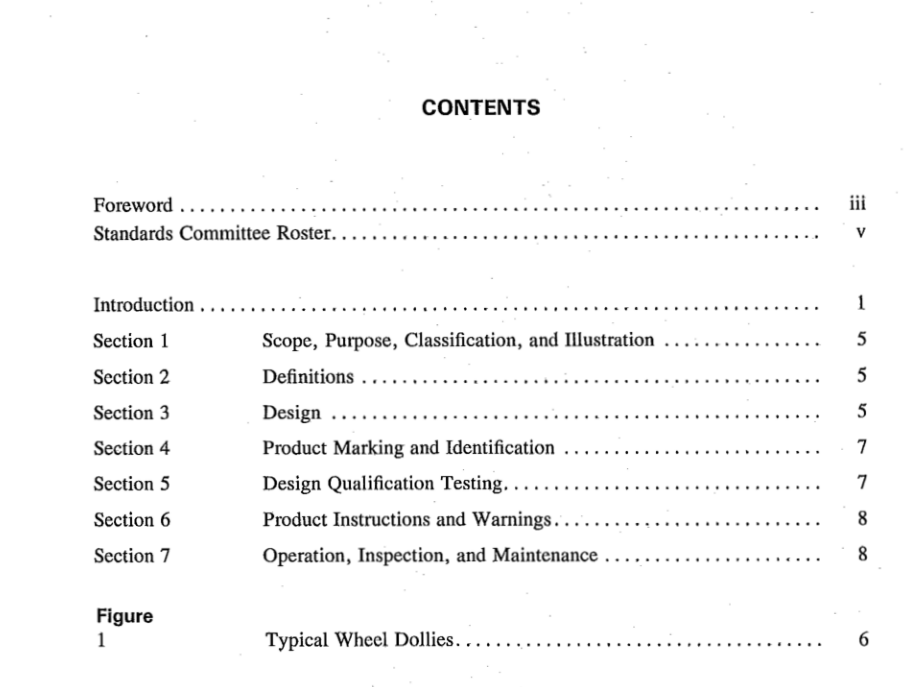ASME PALD 11:1986 pdf free download SAFETY STANDARDS FOR PORTABLE AUTOMOTIVE LIFTING DEVICES Introduction
3.2 Travel Limit
Each wheel dolly shall be provided with a positivemeans to prevent the load from being raised or loweredbeyond the design limit of travel.
3.3 Overload Capacity
All wheel dollies shall be designed to meet the re-quirements of para. 3.4 of this Standard as minimumoverload capacity.
3.4 Proof Load
Whecl dollies shall be capable of lifting and sustain-ing a proof load of 150% of rated capacity applied tothe rollers midway between the front and rear of themember.
3.5 Rollers
The lifting member shall be equipped with rollcrs to permit the rotation of wheel assemblies for the purposcof aligning bolt holes to their mating wheel studs.
3.6 Load Restraint
The load restraint shall be so designed and positionedas to prevent the inadvertent loss of the load during op-
eration and movement of the wheel dolly.
3.7Tilt Mechanism
When a tilt mechanism is provided,it shall be sodesigned to allow the lifting member to be adjusted rel-ative to the horizontal plane,and it shall require inten-tional positive action by the operator to change the angleof tilt.
Section 4 — Production Marking and
ldentification
4.1 Capacity Information
All wheel dollies shall have the rated capacity markedin a prominent location on the product by means of cast-ing imprint, metal stamp, or by use of durable materialsand attaching methods.
4.2 ldentification
Each wheel dolly shall include identification or iden-tifying marks of the original manufacturer by label, de-cal, cast imprint, or metal stamp.
4.3 Date Stamp
Each wheel dolly shall be marked with a serial num-ber or date code of manufacturc.
4.4 Warning
A warning shall be affixed by use of durable materialsand attaching methods to each wheel dolly in a locationreadily visible to the operator. The warning shall bestated per the manufacturerlsupplier’s preference andshall contain the following:
()the word WARNING as a heading;
(b)a statement of the hazard related to the warning;c)a statenent of what to do to avoid or reduce thehazard;
(d) a statement to warn the operator to study , under-stand, and follow all instructions.
The warning statement may include symbols.Example of a warning:
DO NOT LOAD THIS WHEEL DOLLY BEYONDITS RATED CAPACITY. OVERLOADING CANCAUSE DAMAGETO ORFAILURE OFTHEPRODUCT. APPLY LOAD As CLOSE TOTHELIFTING FRAME AS POSSIBLE.BEFORE Mov-INGTHE LOAD,LOWERTHE LIFTING ARMSAND ASSURE THAT LOAD IS CENTERED ANDSECURED WITH A LOAD RESTRAINT DEVICE.THIS WHEEL DOLLY IS DESIGNED FOR USEONLY ON HARD LEVELSURFACES CAPABLEOFSUSTAINING THE LOAD.USE ON OTHER THANHARD LEVELSURFACES CAN CAUSE INSTA-BILITY AND POSSIBLE LosS OF LOAD.
FAILURE TO HEED THESE WARNINGS MAYRESULT IN LOss OF LOAD,DAMAGE TO THEwHEEL DOLLY,AND/OR FAILURE RESULTINGIN PERSONAL INJURY OR PROPERTY DAMAGE.STUDY,UNDERSTAND,AND FOLLOw ALLINSTRUCTIONS.
Section 5 – Design Qualification Testing5.1 Proof Tests
For each design or design change which may affectthe wheel dolly’s ability to meet this Standard, samplewheel dollies built to design specifications shall be proof
ASME PALD 11:1986 pdf free download
